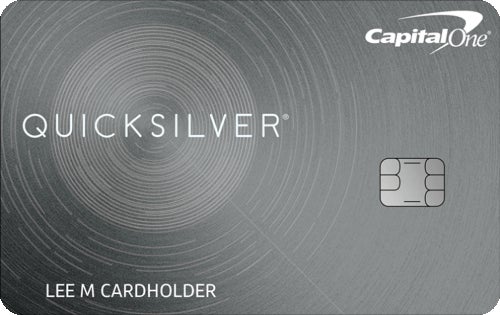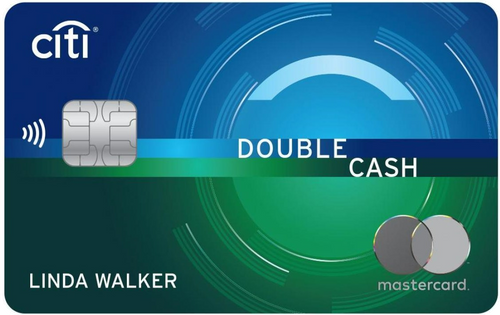While rewards credit cards tend to come and go, two cash-back credit cards that remain popular are the Capital One Quicksilver Rewards Credit Card* and the Citi Double Cash® Card. Both offer flat-rate rewards, welcome bonuses, no annual fees and introductory APR offers on balance transfers.
The Double Cash offers a higher rewards rate of 2% back on all spending (1% when you buy and 1% when you pay for those purchases), which slightly edges out the Capital One Quicksilver with its 1.5% cash back on every purchase, every day, although the Quicksilver card’s perks and generous APR offer on purchases keeps this race a tight one.
Comparing annual fees
Winner: Tie
- $0
- $0
Neither the Capital One Quicksilver nor the Double Cash card charge an annual fee. This makes both a good option if you don’t spend enough to offset a fee with rewards or if you don’t want to take on another yearly cost.
Welcome offer
Winner: Capital One Quicksilver Rewards
- Earn a one-time $200 cash bonus after you spend $500 on purchases within 3 months from account opening
- Earn $200 cash back after you spend $1,500 on purchases in the first 6 months of account opening. This bonus offer will be fulfilled as 20,000 ThankYou® Points, which can be redeemed for $200 cash back.
The Capital One Quicksilver Rewards edges out the Citi Double Cash Card in this category. With the Capital One Quicksilver Rewards, new cardmembers can earn a $200 cash bonus after spending $500 on purchases within three months of opening an account. With the Citi Double Cash Card, you can earn $200 cash back after you spend $1,500 on purchases in the first six months of account opening. This bonus offer will be fulfilled as 20,000 ThankYou® Points, which can be redeemed for $200 cash back.
For some perspective, you’d need to spend an average of $167 each month for three months to earn the $200 cash bonus with the Capital One Quicksilver. For the Citi Double Cash Card, you’d have to spend an average of $250 every month for six months to earn the $200 cash back bonus.
Rewards and redemption
Winner: Citi Double Cash
- Earn unlimited 5% cash back on hotels and rental cars booked through Capital One Travel, where you’ll get Capital One’s best prices on thousands of trip options. Terms apply
- Earn unlimited 1.5% cash back on every purchase, every day
- Plus, for a limited time, earn 5% total cash back on hotel, car rentals and attractions booked on the Citi Travel℠ portal through 12/31/24.
- Earn 2% on every purchase with unlimited 1% cash back when you buy, plus an additional 1% as you pay for those purchases. To earn cash back, pay at least the minimum due on time.
The Double Cash has a higher cash-back rate than the Quicksilver, making it the clear winner.
Although .5% might not sound like a lot, if you spent $10,000 a year with each card, you’d earn $200 cash back with Double Cash and $150 with Quicksilver. Over time, that can really add up.
When it comes to redemptions, these two credit cards essentially tie. Both let you redeem for direct deposits, statement credits and gift cards. While the Double Cash lets you redeem rewards for Amazon purchases, the Quicksilver lets you use rewards with Amazon and PayPal.
Introductory APR
Winner: Capital One Quicksilver Rewards
- 0% introductory APR on purchases for 15 months and on balance transfers alike (19.99% to 29.99% variable APR thereafter)
- 0% introductory APR on balance transfers for 18 months (19.24% to 29.24% variable APR thereafter). Balance transfers must be completed within four months of account opening.
The Capital One Quicksilver Rewards comes with an introductory 0% APR on purchases and balance transfers for 15 months (then 19.99% to 29.99% variable). The Double Cash has a longer introductory APR offer, but it applies only to balance transfers.
While a 0% APR on balance transfers can make sense in certain situations, it’s never a good idea to consolidate debt on a credit card while continuing to use it for new purchases. If you add purchases to a credit card you’ve transferred a balance to, it’ll take longer for you to get out of credit card debt.
Having an introductory APR for purchases is more useful on a rewards credit card than a balance transfer offer. Considering the Quicksilver has both, it stands out in this category.
Card perks
Winner: Capital One Quicksilver Rewards
- No foreign transaction fees
- Capital One Dining access
- Capital One Entertainment access
- Six months of complimentary Uber one membership (valid through Nov. 14, 2024)
- Extended warranty coverage
- Travel accident insurance**
- 24-hour travel assistance services
- Complimentary concierge service
- Citi Entertainment
Neither of these credit cards have as many benefits as more robust rewards cards, but the Capital One Quicksilver has more to offer.
The bottom line
While the Capital One Quicksilver Rewards and the Citi Double Cash® Card have similar welcome bonuses and no annual fees, the Citi Double Cash Card comes out as the winner with its higher rewards rate and a longer balance transfer offer.
However, if you’re looking for a card to use overseas or to finance a planned purchase, the Capital One Quicksilver Rewards could be a better option for you.
FAQs
Extended warranty protection extends a manufacturer’s warranty by up to two years, depending on the coverage. You’ll have to pay for the item with an eligible credit card for coverage to apply.
The Double Cash charges 3% in foreign transaction fees when you use it for purchases abroad. The Quicksilver does not charge foreign transaction fees.
*All information about the Capital One Quicksilver Cash Rewards card has been collected independently by CNET and has not been reviewed by the issuer.
**For Capital One products listed on this page, some of the above benefits are provided by Visa®️ or Mastercard®️ and may vary by product. See the respective Guide to Benefits for details, as terms and exclusions apply
The editorial content on this page is based solely on objective, independent assessments by our writers and is not influenced by advertising or partnerships. It has not been provided or commissioned by any third party. However, we may receive compensation when you click on links to products or services offered by our partners.



